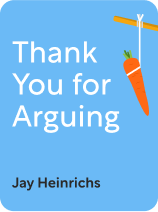

This article is an excerpt from the Shortform book guide to "Thank You for Arguing" by Jay Heinrichs. Shortform has the world's best summaries and analyses of books you should be reading.
Like this article? Sign up for a free trial here .
What is logos in the context of persuasion? How do you use logos in a persuasive argument?
Logos, in terms of a persuasive argument, is appealing to the audience’s logic or reason. Jay Heinrichs, the author of Thank You for Arguing, outlines four steps for using logos to your advantage.
Here’s how to use logos in a persuasive argument.
Use Logos to Persuade Your Audience
The persuasive appeal, logos, bolsters arguments meant to achieve the goal of changing your audience’s mind. Heinrichs explains that logos helps you use your audience’s logic and beliefs to make your desired choice look as advantageous as possible. This means presenting the argument most persuasive to your audience rather than most persuasive to you.
(Shortform note: According to psychologists, nothing is more persuasive to a person than their own argument because we have a natural preference for consistency. In other words, we’d much prefer to stick by our viewpoint than switch to a new one. By mirroring your audience’s existing viewpoint, your argument circumvents this issue.)
Heinrichs explains that there are four steps to using logos effectively: finding your audience’s truism, determining the most persuasive reasoning type, defining the argument terms to your advantage, and turning your focus to the future. Here’s how to use logos to persuade your audience:
Step 1: Find the Audience Truism
You first need to figure out your audience’s truism: a commonly held opinion or belief that represents the audience’s values. Heinrichs notes that different audiences will hold different truisms because truisms aren’t factual—a truism is more like a rule of thumb. For example, “I have a lot of money” is a fact. On the other hand, “Being rich is good because it means you’ve worked hard” is a truism.
(Shortform note: Whether you’re aware of it or not, most advertising these days is meant to tap into your truisms. In All Marketers Are Liars, Seth Godin explains that while older marketing models relied on marketing leading the customer’s buying habits, modern marketing models let the customer lead the marketing. In other words, advertisers keep close tabs on your behaviors and habits to better understand your beliefs and world perspective, and then tailor their marketing campaigns to match.)
Heinrichs cites three ways to spot your audience’s truisms:
1) Repetition: Listen to the way your audience communicates. Often, they’ll have certain terms or phrases they repeat—these are their beliefs and opinions. For example, someone might say, “The candidate’s honesty is refreshing. I appreciate a politician who tells it like it is. With all the misinformation in DC nowadays, you want someone who gives it to you straight.” This person’s truism is that perceived honesty is desirable in a candidate.
(Shortform note: In Difficult Conversations, the authors note that repetition is a sign that someone feels like they’re not being heard. When you listen to—and use—someone’s repeated truism in your argument, you give yourself a significant leg up just by demonstrating that you’ve been listening closely to them.)
2) Rejection: If you present a choice that your audience rejects, listen to the phrases they use in rejecting you—often they’ll offer reasoning that reveals their truism.
For example, you’re trying to get a friend to adopt one of your pit bull’s puppies. She refuses, saying, “What’ll I do when it gets big and aggressive?” You explain that pit bulls aren’t necessarily an aggressive breed. “No way,” she says. “What if it bites my kid?” You stress that socialization and proper training prevent aggression. “Well,” she says, “a labrador would never go after you like a pit bull would.” From this exchange, you know your friend’s truism: Pit bulls are a dangerous and aggressive breed.
(Shortform note: If your audience isn’t forthcoming with their opinions, you can try to spur them on with what Kim Scott (Radical Candor) calls “loud listening.” This type of listening involves saying something that will prompt the other person to react strongly or push back on what you have to say—in all likelihood, exposing their truisms in doing so.)
3) Labeling: Sometimes, Heinrichs points out, people label an idea or proposition to make you feel a certain way about it. For example, politicians call tax cuts “tax relief” because people can generally agree on the truism, “It’s a good thing to be relieved of excessive taxes.”
(Shortform note: If you catch your opponent using labeling, be careful to stay focused on the central issue. Many people use labels as a “red herring” that distracts you from the main issue and sends you down an unrelated argumentative path.)
Step 2: Decide On the Most Persuasive Reasoning Type
Next, in an appeal based on logos, Heinrichs says you’ll use what you know of your audience’s values to either use their truism to your advantage (through deductive reasoning), or create a new truism that they can get on board with (through inductive reasoning).
Deductive Reasoning
A truism is “usable” when the choice you offer aligns with your audience’s beliefs. In these cases, you’ll use deductive reasoning, which uses the truism to demonstrate that your choice is best for them.
Heinrichs advises using an argument that connects the belief with an action: “Because you believe [truism], you should [choice].” You don’t explicitly state that the choice will deliver on the opinion or belief—instead, you depend on juxtaposition to prompt the audience to infer a link between the two.
For example, if your audience’s truism is that the American health care system should be improved, your argument might look like, “If you think the American health care system should be improved, you should vote for the Green Party.” You never state that the Green Party will do something to improve the health care system, but your audience will assume there’s a link.
(Shortform note: The argument that builds out of deductive reasoning is what Aristotle called the enthymeme. The defining characteristic of an enthymeme is that one of the premises that leads to the conclusion is omitted or implied—in the example above, the implied premise is, “The Green Party has a plan to improve the health care system.” Be aware that an astute audience may pick up on the fact that the vital premise that leads to the conclusion is missing—so be ready with an answer in case they ask you about it.)
Inductive Reasoning
A truism is “unusable” if a) you don’t know what it is, b) it seems that your choice is far from your audience’s beliefs, or c) the audience doesn’t have clear shared beliefs.
In these cases, Heinrichs says, you’ll need to use inductive reasoning, or give examples through facts or storytelling that prove your choice is the best one. (You can think of this as the inverse of deductive logic—whereas deductive logic views circumstances through the filter of audience belief, inductive logic creates the circumstances that form the belief.)
For example, your audience can’t agree on whether the health care system needs improvement, so you can’t use it as your truism. Change your reasoning to inductive—create proof that the Green Party is the best choice: “Studies show that cities with Green Party leadership have lower levels of pollution and higher levels of regular exercise. So, these cities pump fewer taxpayer dollars into Medicare and put more into education and infrastructure. I don’t know about you, but I’d love to see my taxes fixing our roads instead of being unnecessarily spent on preventable diseases! The Green Party can make that happen.”
(Shortform note: Heinrichs’s section on inductive reasoning is likely an area of focus for his critics that call his suggestions manipulative or deceptive. Inductive reasoning can feel like an especially problematic aspect of rhetoric because it relies heavily on inferences and comparison between non-alike subjects—thereby leading to inaccurate inferences and unfair judgments.)
Step 3: Define Terms to Your Advantage
Once you’ve figured out what your audience values, or you’ve given them something to value, use this knowledge to attach positively regarded terms to the concepts you’re going to argue. Additionally, be careful to refuse any negative or anti-truism terms your opponent tries to place on you. Heinrichs explains that these practices help you put your argument into a context that you control.
(Shortform note: Controlling the context of the argument is critical to your success because of the many subtle messages it sends to your audience. From context, they understand how much importance to place on your argument versus your opponent’s and what assumptions they can make about each person’s argument. If you lose control of the context, your audience may find your opponent’s argument more important and assume that their proposed choices will be better.)
Heinrichs notes several tools for tilting an argument in your favor: creating your own terms and redefining your opponent’s terms.
Tool 1: Create Your Own Terms
Frame issues in a way that emphasizes your audience’s truisms or beliefs—Heinrichs says this lends emotional impact to your argument. Attach positive and appealing terms to yourself and negative or unappealing words to your opponent.
For example, in speaking to a fiscally conservative audience, you might call yourself “fiscally responsible” and your opponent “a frivolous spender.” In speaking to a fiscally liberal audience, you might call yourself “focused on sustainable choices” and your opponent “wasteful.”
Tool 2: Redefine Your Opponent’s Terms
If your opponent attaches certain terms to you, Heinrichs advises that you accept them, but redefine them so they work in your favor.
Imagine an opponent tries to attack your bid to increase funding for the postal service: “The postal service is outdated!” You can reply, “If by ‘outdated’ you mean ‘providing essential services to our country’s citizens for decades,’ then yes, it’s outdated.” Here, you’ve turned the negative “outdated” label into a positive.
| Why Do the Terms Matter So Much? Attaching certain terms to yourself, your opponent, and your argument is important because, as Jonathan Haidt explains in The Righteous Mind, humans respond more strongly and quickly to intuition than they do reason. In other words, when you attach positive terms to yourself and your argument and negative terms to your opponent, your audience immediately, intuitively feels that you’re the better choice. Even as their rational brains catch up and start to think critically about the arguments that you and your opponent present, their first impression of you sticks with them and gives you a significant leg up. |
Step 4: Talk About the Future
Once you’ve identified the truisms and landed on a crowd-pleasing definition of the issue, move your argument toward the future—that is, explain what you plan to do about it. For example, you might say, “I want the postal service to continue providing its essential services. That’s why I’m proposing a new program that helps get younger employees in the door.”
(Shortform note: When announcing your plan, remember to continually remind your audience of its value to them. In Radical Candor, Kim Scott notes that when you fail to regularly communicate the value of a decision or plan to those affected by it, they start to feel unimportant and disconnected—feelings that may lead them to eventually turn against you.)

———End of Preview———
Like what you just read? Read the rest of the world's best book summary and analysis of Jay Heinrichs's "Thank You for Arguing" at Shortform .
Here's what you'll find in our full Thank You for Arguing summary :
- Smarter ways to argue and evaluate others’ arguments
- How to persuade people to do what you want
- How you can get a bully to talk himself down






